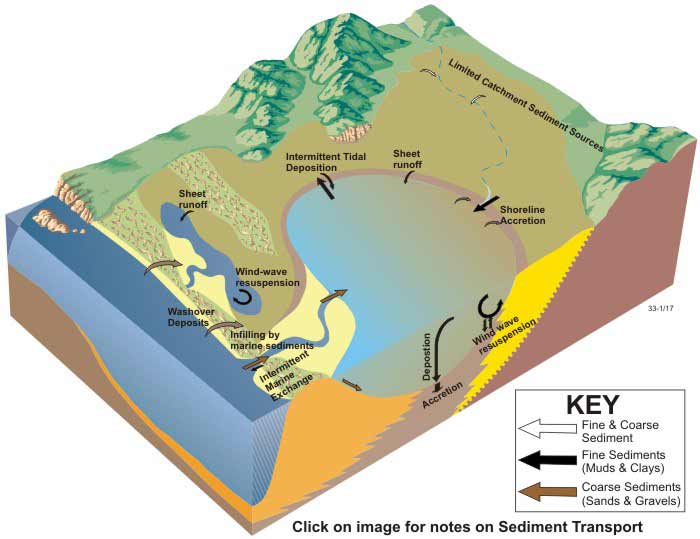
Sediment transport processes in coastal lagoons and strandplains
1. Limited sediment input
Sediment inputs from the catchment are less important in coastal lagoons – significant input typically occurs during high rainfall events only. Most terrigenous sediment tends to be fine, and is derived from sheet runoff and aeolian inputs.
2. Accretion of mudflats
Fine sediment (e.g. muds, clays and organic material) undergoes both deposition and erosion on unvegetated intertidal flats, aided by biological activity such as burrowing. A general trend of slow growth of intertidal flats is observed.
3. Deposition and erosion from intertidal flats
Some deposition of fine sediment occurs on flanking environments, aided by the baffling effects of vegetation such as saltmarshes (Boorman et al., 1998, Brown, 1998, Saintlan et al., 1999, Laegdsgaard, 2001), however this is limited by poor tidal penetration into the lagoon.
4. Fine sediment deposition
Fine suspended sediment is transported into the central basin, where deposition can occur, depending on wind-wave conditions within the coastal lagoon. Benthic micro-algae (BMA), where present, assist in the stabilisation of fine sediment (Wulff et al., 1997, Cahoon et al., 1999, Murray et al., 2002). Seagrasses, where present, also promote sedimentation and stabilise the substrate (Moriarty et al., 1985), however seagrass growth may be limited by poor tidal penetration. Flocculation (particle aggregation due to changes in salinity) is less important in coastal lagoons as they often lack fresh water input. Organic matter (derived from the catchment and also produced in situ) accumulates, and may be eroded during open phases. Coastal lagoons and strandplain-associated coastal creeks with closed entrances trap nearly 100% of the sediment delivered to the basin. Due to the negligible freshwater input, even during floods this material may not be completely eroded, even during floods that manage to cut a new opening in the barrier.
5. Resuspension of fine sediment by wind waves
As the average depth of coastal lagoons tends to be above the wave base, wind-wave induced resuspension of fine sediment is common. Lack of seagrasses and other stabilising vegetation also contributes, leading to high water column turbidity.
6. Infilling by coarse marine sediments
Entrances of coastal lagoons tend to be intermittently open and closed, and many tend to remain closed for the majority of the time. Sedimentary processes here are dominated by the landward transport of coarse sediment derived from the marine environment, although this is restricted by the narrow and often closed entrance channel. This coarse sediment tends to choke the entrance, and builds out into the central basin, forming a flood (or marine) tidal delta. A small amount of fine sediment can be exported into the marine environment during extreme high flow events.
7. Washover deposits (storm events)
Coarse sediment derived from the marine environment is driven along the coast by strong wave energy (particularly during storms), forming a distinctive barrier at the entrance (Otvos, 2000). During extreme events, washovers can occur, depositing further coarse sediment into the central basin of the coastal lagoon.


